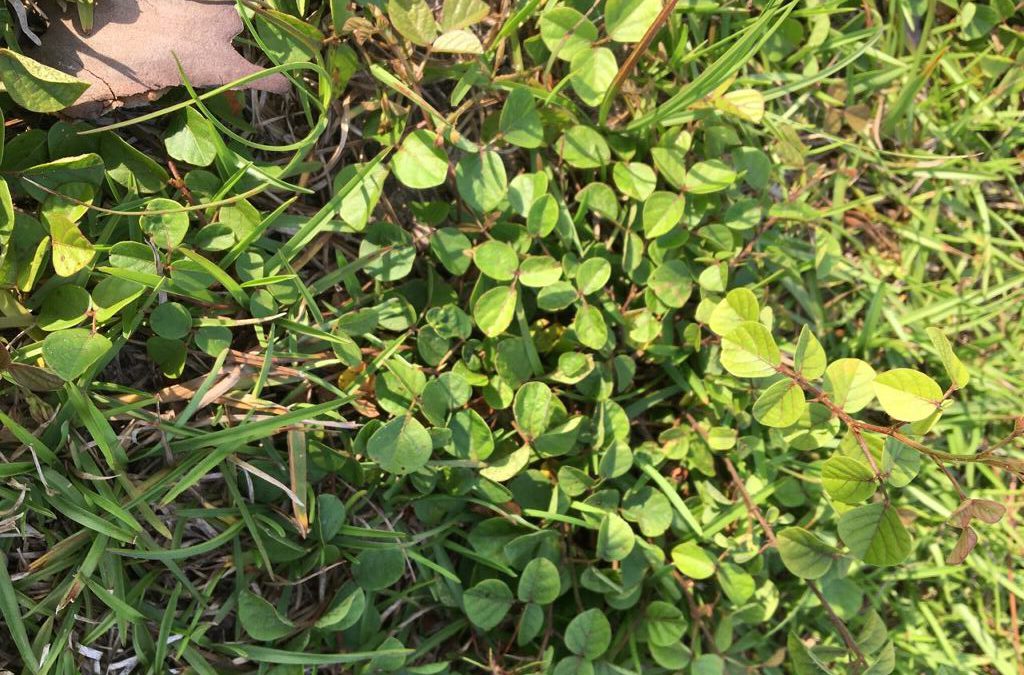
by Ashley Stonecipher | Jun 21, 2022
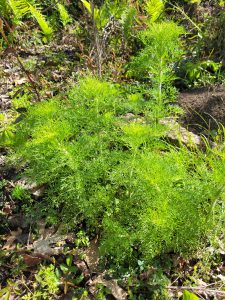 Summer weeds are here. What should we do? As we are officially into summer you are probably noticing many of those summer weeds poking through your lawn by now, or perhaps they have taken over completely. Do not give up, there is still hope for a beautiful lawn with less weeds.
Summer weeds are here. What should we do? As we are officially into summer you are probably noticing many of those summer weeds poking through your lawn by now, or perhaps they have taken over completely. Do not give up, there is still hope for a beautiful lawn with less weeds.
The first thing is to be able to identify the weed and identify the type of grass. Now you may be thinking that is impossible and maybe you are thinking why it is important to identify those? The answer to that question is simply that not all chemicals are the same and understanding what you have and the best time of year to spray for that will save you both time and money. Weeds fall into three categories: Broadleaf, Grass, and Sedge. Remember, a weed could be any plant that is out of place. Weeds will compete with desirable plants for nutrients, water, light, and space.
Once you understand what category your weed falls into the next step is to know the life cycle. For example, winter annuals will die out naturally as the temperatures increase and a chemical may not be needed. There are weeds that complete their cycle in one year (winter and summer weeds) and there are weeds that complete their cycle in two years (biennials). A biennial has vegetative growth the first year and will flower and die the second year, examples are Carolina false dandelion, Oldfield toadflax, and cudweed.
Next you will want to identify the indicator species. What does this mean? It means that there are some weeds that grow well in compacted soils like goosegrass and annual bluegrass. Others like it very wet (poor drainage) such as dollar weed, sedges and torpedo grass. While there are weeds such as sandbur and rustweed that like it very dry and sandy. Knowing this can help you do preventative weed control. Grow a healthy turf starting with the right selection, proper cultural practices, pest control, traffic control, and sanitation.
When you are faced with the decision to use chemicals to combat your lawn weeds there are a few things to know. There are selective herbicides that control certain species without hurting others (your lawn) and there are nonselective herbicides that control green plants regardless of species. Also, there are contact herbicides, which are exactly how their name implies. They affect only the portion of the plant that the herbicide touches. There are also systemic herbicides which are translocated through plant’s vascular system.
The best time to spray herbicides is when the weeds are actively growing, young and not drought stressed or producing seed heads. A table below shows the active ingredients best for the three categories of weeds.
|
Broadleaf Weeds |
Grassy Weeds |
Sedge Weeds |
| Centipede |
2-4D + Dicamba +MCPP Thiencarbazone+iodosulfuron + dicamba |
Sethoxydim |
Halosulfuron-methy, Sulfentrazone, Imazaquin, Bentazon, |
| Bermuda |
2-4D + Dicamba +MCPP Thiencarbazone+iodosulfuron + dicamba |
Quinclorac |
Halosulfuron-methy, Sulfentrazone, Imazaquin, Bentazon, |
| Zoysia |
2-4D + Dicamba +MCPP Thiencarbazone+iodosulfuron + dicamba |
Fluazifop, Quinclorac |
Halosulfuron-methy, Sulfentrazone, Imazaquin, Bentazon, |
| St. Augustine |
2-4D + Dicamba +MCPP Thiencarbazone+iodosulfuron + dicamba |
None |
Halosulfuron-methy, Sulfentrazone, Imazaquin, Bentazon, |
|
**temperature restrictions |
|
|
The key is to identify the type of turf you have and the type of weeds you have in the lawn. Further, look into if there are any factors that can be adjusted that might be causing the excess of weeds. And lastly, make sure you are using the right method, chemical, and timing for control. For more information on summer weeds and lawns, please contact your local county extension office.
Information for this article can be found Managing Weeds in Warm Season Lawns | Home & Garden Information Center (clemson.edu)
by Sheila Dunning | Jun 14, 2022
Florida is rapidly urbanizing with 1,000 people a day moving into the state. Many cities in the panhandle have experienced accelerated growth rates over the past ten years. Crestview is one of the seven areas in the state with a population growth of 19% or greater, and the only one located in the panhandle. The 2030 predictions for Florida are another 6 million people, with counties containing military personnel increasing the quickest.
All of these people need water to meet their daily living needs. The average person in the United States uses 101.5 gallons of water per day. Residential water use comprises 61% of the public supply category. This category is responsible for the largest single portion (43%) of groundwater withdrawal in Florida. The Floridan aquifer spans an area of about 100,000 square miles in the southeastern United States, including all of Florida, as well as, portions of three other states. At the current statewide population growth rate, Florida is facing a 300 million gallon per day shortfall of future water needs, possibly as early as 2030.
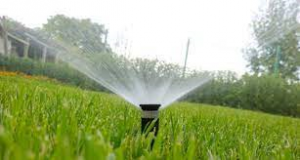 Turfgrass is a key landscape component and often the most commonly used single type of plant in the residential landscape. However, on a hot, sunny day in midsummer, the average lawn uses 125 gallons of water per 1,000 square feet. Although Florida has a humid climate where the precipitation rate, on average, is greater than the evapotranspiration rate, the low water-holding capacity of the soil makes irrigation necessary for the high quality landscapes desired by homeowners. But, watering the yard requires an entire household to skip a shower, not wash anything and avoid cleaning. Or, we need to find ways to use a different source of water for irrigation and conserve the potable water for the people.
Turfgrass is a key landscape component and often the most commonly used single type of plant in the residential landscape. However, on a hot, sunny day in midsummer, the average lawn uses 125 gallons of water per 1,000 square feet. Although Florida has a humid climate where the precipitation rate, on average, is greater than the evapotranspiration rate, the low water-holding capacity of the soil makes irrigation necessary for the high quality landscapes desired by homeowners. But, watering the yard requires an entire household to skip a shower, not wash anything and avoid cleaning. Or, we need to find ways to use a different source of water for irrigation and conserve the potable water for the people.
While the use of reclaimed water for landscape plants has become a standard in many parts of Florida, it has limited availability in the panhandle. However, there are many ways to reduce and conserve potable water use for those with in-ground irrigation systems. First, make sure you have a functional rain shut-off device. By design it will prevent the system from running when it has recently rained. On average, the panhandle has received rain about every 4 days this year. Besides, Florida law requires a rain shut-off device for all irrigation systems, new or old.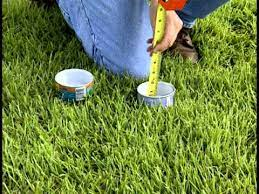
Then, calibrate each zone to determine the length of time required to deliver ½ inch of water. This can be determined by placing 10 or more, short, straight-sided containers throughout the irrigation zone. Run the system and look at each container, measuring the depth with a ruler. Adjust the run time so the system only delivers ½ inch. Now set the clock to run 2-3 times a week for that length of time. It’s that simple. And the water savings is significant. For these and many other irrigation tips, visit askIFAS at https://edis.ifas.ufl.edu/.
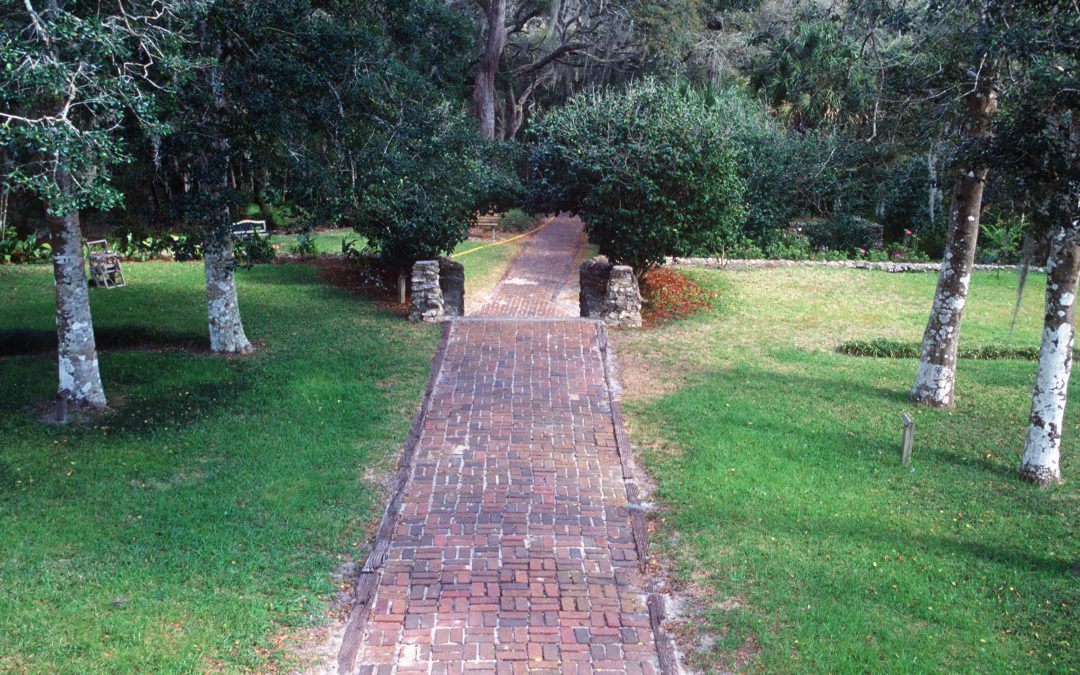
by Joshua Criss | Jun 2, 2022
The lawn is a staple when you picture the typical American home. It is where your kids play, where you stand to associate with your neighbors and the first impression you give to passers-by. It has also no doubt been a subject of frustration as you notice brown patches or open spots. Could this situation have been avoided in the first place? Lawn care is a topic we address in extension extensively. Proper maintenance practices will help your lawn be green and healthy providing you with years of enjoyment. Below are a few principles that if applied will help you avoid issues and grow a worry-free yard.
First Steps
Before you do anything else you will need to know what species you are working with. In this area we have warm season grasses with names like centipede and zoysia. Their individual characteristics will identify yours from the others. For instance, centipede grass is a lighter color with a course textured blade about 1/16 to 1/8 inches wide and a creeping habit as it spreads via stolon. This is very basic, as identifying grasses could be a day long course on its own. Knowing your lawn species will inform you as to mowing height and when periodic tasks such as dethatching may be necessary. All of these are necessities for a healthy lawn, but there are two universal tasks that need to be on the forefront of your mind.
Irrigation
Irrigation is arguably the most important topic in lawn care. Improper watering may cause your grass to die back opening bare spots for weeds and insects to infiltrate. Scheduled irrigation is not the best option. Your grass will tell you when it needs water. Look for indicators such as folding blades, color change, and lingering footprints as keys to irrigation. When you see these, apply ½ to ¾ inch of water preferably in the early morning. Take your soil type into consideration when watering as you will want this water in the root zone. Sandy soils may need a little more to saturate the area while clay may need to soak in through multiple applications. Watering only when required will encourage deeper rooting of your grass. So, how do you know how long to run your system? Calibrate your system by placing straight sided cans in your watering zones. Run the system until they fill to the desired level. The amount of time this takes will tell you how long you should run the system. While you are calibrating the system, take a look at where the sprinkler heads are aimed. Readjust any that place water in undesired locations like the street. Lastly, install a rain sensor. The Panhandle received an average 68.32 inches of rain in 2021*. There is no need to run your water system if mother nature is doing it for you.
*per FL Climate Survey https://climatecenter.fsu.edu/images/docs/Fla_Annual_climate_summary_2021.pdf
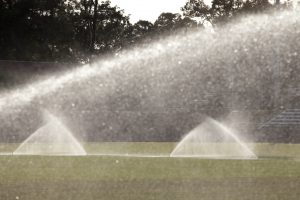
UF/IFAS Photo by Tyler Jones.
Fertilizing
Fertilization is another often misunderstood topic. Grass is a plant, and therefore requires nutrients to thrive. Over doing it in certain grasses may cause them to die back much like improper irrigation. Application rates vary by grass species and are given in terms of required nitrogen per 1000ft2 for a single growing season. You can tell how much Nitrogen a fertilizer has by looking at the first of the three-digit NPK rating. It indicates the amount by weight in the bag (8-8-8 = 0.08lbs nitrogen per 1lb fertilizer). Keep in mind that rate of fertilizer your grass needs is for the entire year. This means you will want to apply multiple times. So, if you need 13lbs of fertilizer it is best to apply about 4.33lbs three times across the growing season versus all at once. Only apply fertilizer during active growth. In the Panhandle this is mid-April through mid-September. Appropriate rates and timing will keep those expensive fertilizers in your root zone and not in our local waterways.
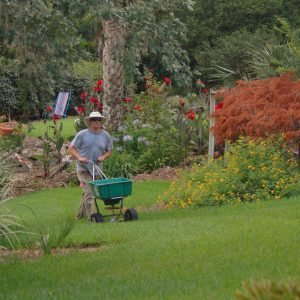
UF/IFAS Photo
Appropriate care will provide lush healthy growth and a full lawn. Taking the time to identify your grasses will inform you as to what it needs to support your family for years to come. Appropriate irrigation and fertilization will in-turn support the health of local watersheds and potentially save you some money and effort. For more information on lawn maintenance, see these Ask IFAS documents, or contact your local extension agent for additional information on this and any topic regarding your gardens and more.
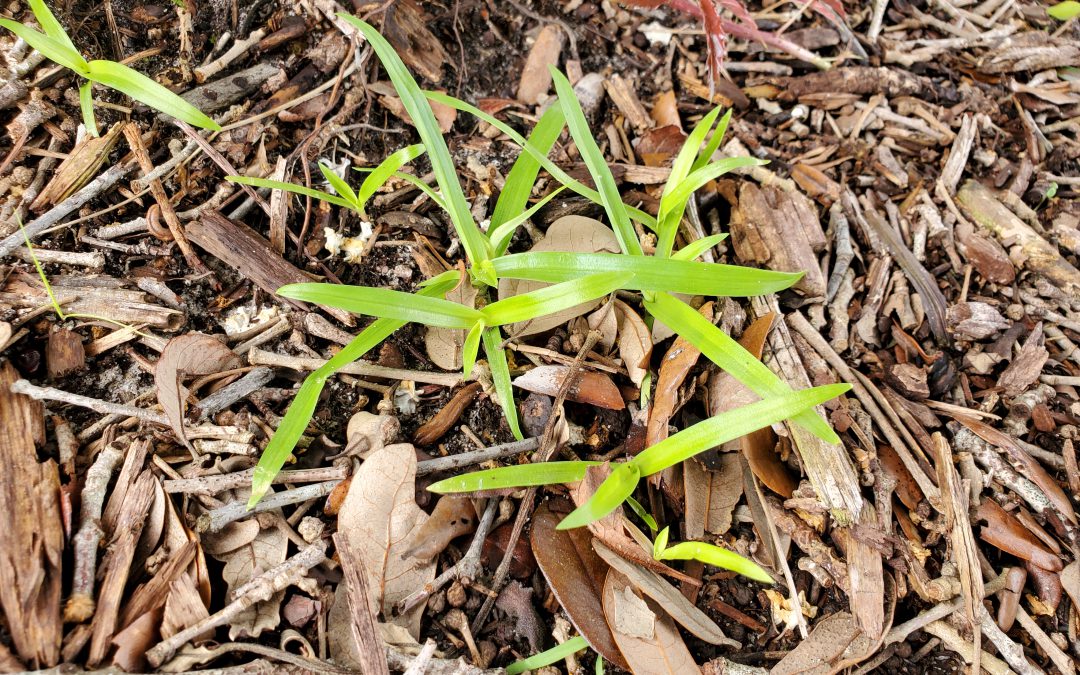
by Daniel J. Leonard | May 12, 2022
It’s the most asked question of Extension agents everywhere. “What is this weed and what herbicide should I buy to kill it?” The first part of that question is straightforward. Between personal field experience, formal plant identification training, and a team of weed science specialists to call on, Florida Extension Agents can get your weed accurately identified. The second part of the question is slightly more nuanced. Many weed problems can be avoided by following lawn and landscape Integrated Pest Management (IPM) practices, like not overwatering, mowing at the correct height, using mulch where you can, etc., but sometimes herbicides are required. For these situations, if you follow the “homeowners only need four post-emergent herbicides rule”, you’ll be ready for any weed challenge you face!*
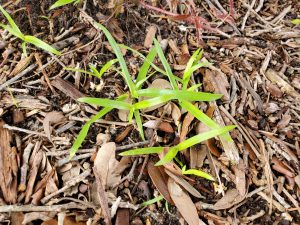
Doveweed seedlings just emerged on July 9, 2021. Photo courtesy of Daniel Leonard.
The first weed scenario you should be prepared for is spot spraying weeds in landscape beds and around hardscapes like concrete pads, sidewalks, pools, driveways, etc. For this situation, you’ll turn to the backbone of the four herbicides rule and a staple in any weed management program, glyphosate. Glyphosate is the active ingredient (AI) in many non-selective products ranging from the infamous Roundup brand to cheaper generics like Killzall and Cornerstone. Glyphostate is extremely cost-efficient and very effective on a huge range of emerged weeds including grassy weeds, broadleaf weeds, and even sedges (also called nutsedge or “nutgrass”). Just be sure not to get any overspray on desirable plants or they’ll be seriously damaged!
The second situation we face occurs when “bad” grassy weeds invade landscape beds, shrubs, and vegetable gardens. These cases call for a grass-selective herbicide that you can spray right over the top of your broadleaf annuals, perennials, and shrubs to take out the unwanted grasses. In this case, there are two options at your disposal: sethoxydim (AI in many products like Fertilome Over the Top, Hi-Yield Grass Killer, Poast, etc.) and fluazifop (AI in the product Fusilade). Both products work well in removing weeds like crabgrass, bermudagrass, goosegrass, and others and can be safely applied over the top of many ornamentals.
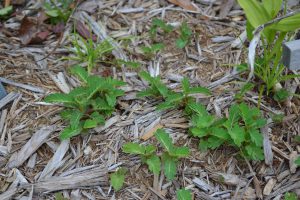
Seeds from annuals like Chamberbitter easily get into mulch and turfgrass from surrounding areas. Photo by Beth Bolles, UF Extension Escambia County
From time to time, we need to treat a broadleaf weed like dollarweed, doveweed, chamberbitter, or any number of others, that have invaded our lawn grass. Some of these weeds are tougher than others, but almost all of them can be managed with the proper rates of 2,4-D, Dicamba, other similar products, or a combination of several of them. These active ingredients have been on the market for decades so there are many generic options at your disposal. However, if you have a truly tough broadleaf weed problem, the newer product Celsius WG from Bayer (a combo of Dicamba and two newer AIs), while a little pricey and only available online or at specialty chemical dealers, is well worth the expense and knocks out the most gnarly of lawn weeds.
Finally, there is a category of weeds that aren’t broadleaves and aren’t quite grasses either. These are the sedges. Commonly known around the Panhandle as “nutgrass”, sedges are a serious pest of lawns, particularly those that stay a little on the damp side, and vegetable gardens. Sedges, with their glossy leaves and distinctive flowers, stand out in lawns and gardens, are very unsightly in an otherwise well-maintained area, and can outcompete the desirable plants they invade. Fortunately, there are several AIs that work very well on sedges and are safe to use around turfgrass and many other plants. The most effective sedge herbicide AI for homeowners is halosulfuron-methyl (AI in Sedgehammer in lawns and Sandea and Profine in vegetables). Sedgehammer works very slowly (results can take up to a month) but is very safe in turfgrass and ornamentals and highly effective! If Sedgehammer and other halosulfuron products are difficult to obtain, Imazaquin is a slightly less effective but more common substitute. This AI can be found in the product Image Kills Nutsedge and is safe for use in turfgrass and most ornamental plantings.
The challenge of controlling the many types of weeds in your lawn, landscape, and vegetable garden seems daunting, but having just four basic classes of herbicides on hand can greatly simplify things! Whether you need to control a broadleaf, grass, or sedge weed problem, putting together a weed control toolbox containing a non-selective herbicide like glyphosate, a broadleaf selective like 2-4,D, a grass selective like sethoxydim, and a sedge selective like halosulfuron-methyl can allow you to handle most any weed you come across at home. For more information on controlling weeds in home landscapes and gardens or any other horticultural topic, contact your local UF/IFAS Extension office. Happy gardening!
*Most homeowners discover weed problems after the weeds are already up and growing, making post-emergent products necessary. Pre-emergent products have a place in weed management programs but are not the focus of this article.
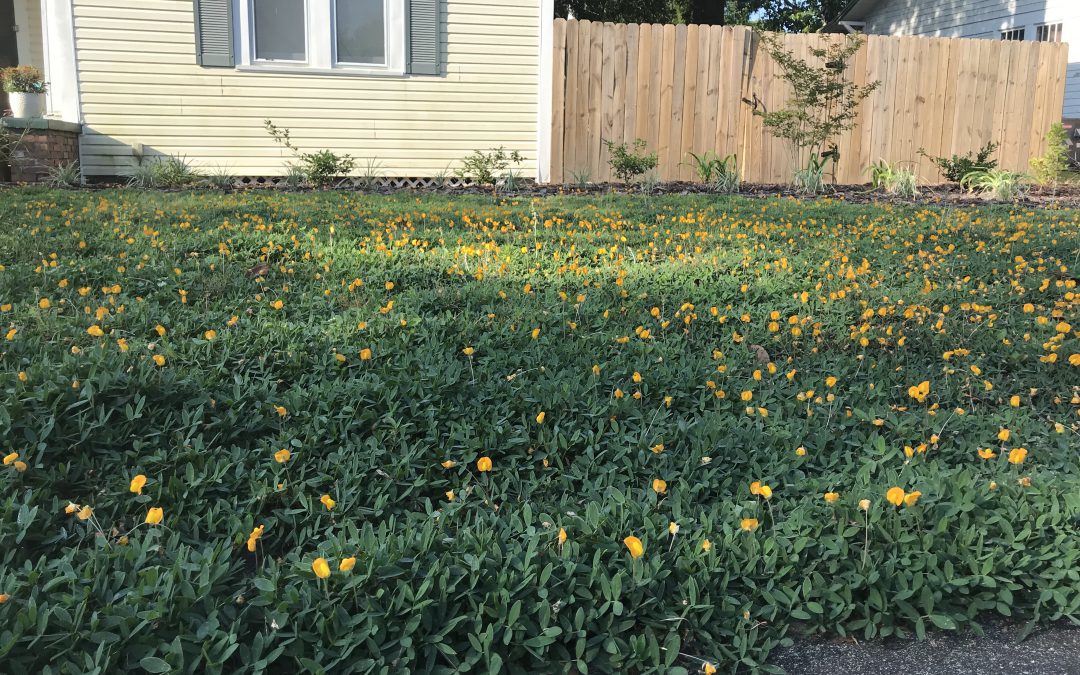
by Matt Lollar | May 5, 2022
Turf lawns provide an excellent groundcover that hold soil in place, filter pollutants, and are beautiful. However, turfgrass may not be your first groundcover choice, due to heavy shade, landscape layout, or just personal preference. In that case, there are a lot of alternative groundcovers on the market. To help determine what groundcovers do best under certain conditions and to provide information on lawncare and groundcover maintenance, this month’s Gardening in the Panhandle LIVE! was all about groundcovers.
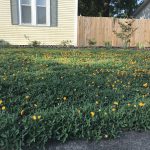
‘Needlepoint’ Perennial Peanut in a yard. Photo Credit: Daniel Leonard, University of Florida/IFAS Extension – Calhoun County
Turfgrass/Groundcover Selection
The University of Florida/IFAS has a long list of publications on alternatives to turfgrass. The comprehensive list can be found at Ask IFAS: Groundcovers.
One of the groundcovers that does well in full sun and has beautiful yellow flowers is perennial peanut. More information on perennial peanut can be found in the publication “Guide to Using Rhizomal Perennial Peanut in the Urban Landscape”.
Groundcover options for the shade include Algerian ivy, Asiatic jasmine, and mondo grass. Read more about these and other shade friendly species at “Gardening Solutions: Groundcovers for the Shade”.
Frogfruit can tolerate full sun and partial shade.
You could also create a wildflower meadow in a sunny spot. More wildflower information is available at Ask IFAS: Performance of Native Florida Plants Under North Florida Conditions.
White clover is a groundcover that may be best suited in a mix with other groundcover species. The publication “White Clover” provides some excellent information on growing this plant.
A number of factors come into play when you are choosing a turfgrass species. Some species are more tolerant of shade than others and maintenance levels are species and variety specific. The “Choosing Grass for Your Lawn” webpages can help answer some common questions. For additional information on turfgrass species a list of EDIS publications and other UF/IFAS websites is available at Ask IFAS: Your Florida Lawn. (Note: Buffalograss is not recommended for Florida.)
Overseeding is not a recommended practice for home lawns, but information is available at the webpage “Overseed Florida Lawns for Winter Color”.
Management of Turf and Groundcovers
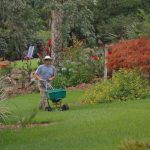
Fertilizing a lawn. Photo Credit: University of Florida
Turfgrass requires the right amount of care. To help maintain a good looking yard, follow the management practices in the publication “Homeowner Best Management Practices for the Home Lawn”.
A soil sample is a good place to start to determine the root of the issues you may have in your lawn. Follow these simple steps to collect and submit a sample for accurate analysis.
Weed management can be difficult in turf and other groundcovers. Cultural, mechanical, and chemical controls can help keep weeds under control. The “Weed Management Guide for Florida Lawns” provides control options for the majority of weeds you’ll encounter in your lawn. More information on weed control in turf alternatives can be found in the publication “Improving Weed Control in Landscape Beds”.
Virginia buttonweed is a common weed that is often difficult to control. Doveweed can also be difficult to control.
The publication “Adopting a Florida Friendly Landscape” outlines the nine principals to help you design, install, and maintain a landscape that will thrive in our climate.
Fertilizer is required to maintain a healthy lawn. A list of lawn fertilization publications and links can be found at Ask IFAS: Lawn Fertilizer.
Lawns in the southeast are susceptible to a number of different diseases mostly thanks to our hot and humid weather. But there are some preventative and curative practices you can implement to help keep disease under control. The “Turfgrass Disease Management” publication answers a lot of questions about disease control.
Past episodes of Gardening in the Panhandle LIVE can be found on our YouTube playlist.

 Summer weeds are here. What should we do? As we are officially into summer you are probably noticing many of those summer weeds poking through your lawn by now, or perhaps they have taken over completely. Do not give up, there is still hope for a beautiful lawn with less weeds.
Summer weeds are here. What should we do? As we are officially into summer you are probably noticing many of those summer weeds poking through your lawn by now, or perhaps they have taken over completely. Do not give up, there is still hope for a beautiful lawn with less weeds.










